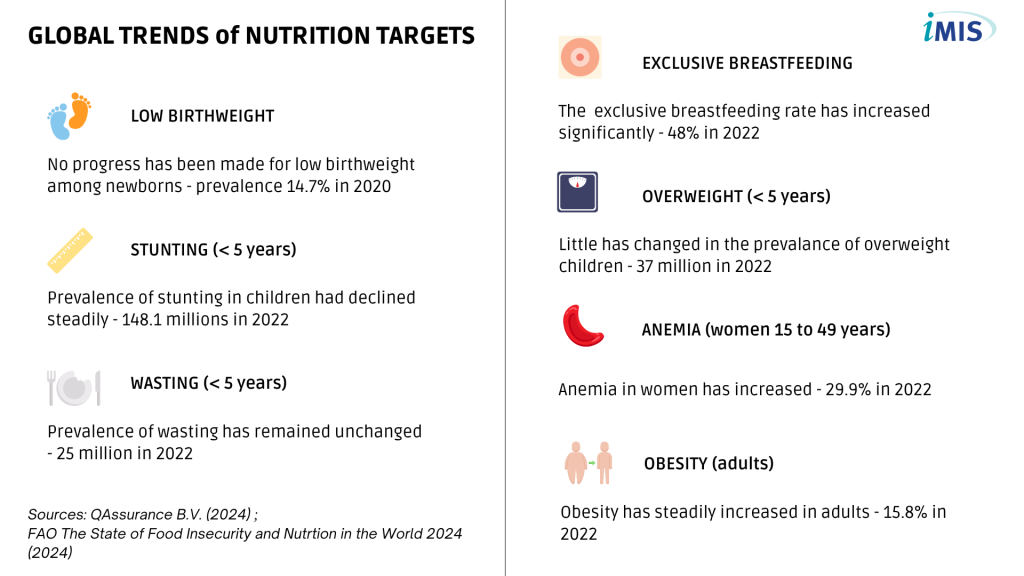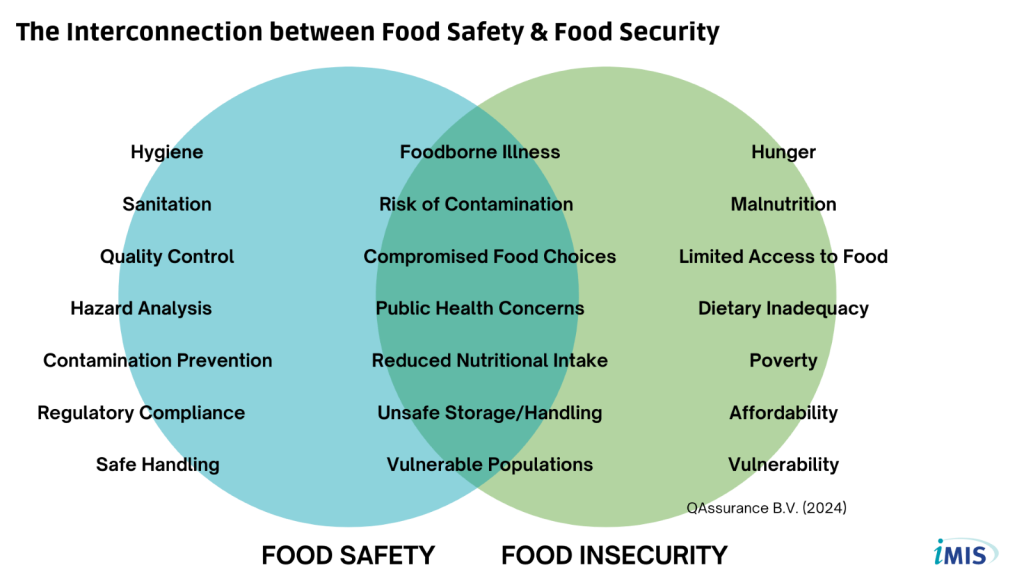Introduction
Despite some progress, global hunger and malnutrition persist, mostly affecting vulnerable populations. According to FAO’s 2024 report “The State of Food Security and Nutrition in the World 2024”, if current trends continue, millions will face food insecurity by 2030. Conflict, climate change, economic woes, and inequality fuel this crisis. Solutions exist, but lack of funding hinders implementation, especially in the hardest-hit nations.
This summary article, drawing on the latest FAO report, explores not only the challenges of food insecurity but also its crucial link with food safety, and examines the current landscape and outlook.
Understanding Healthy Eating
Healthy diets involve consuming diverse foods, balancing macronutrients, and limiting those high in unhealthy fats, sugars, and salt. While food security and healthy diets are connected, the relationship is complex. Food insecurity can impact diets in various ways, potentially contributing to both undernutrition and overweight/obesity.
Higher levels of food insecurity were associated with:
- Less diverse diets, low in animal products and higher in fruits/vegetables, coupled with higher consumption of foods linked to NCDs
- While moderation is observed, it may reflect limited access to diverse food groups, not necessarily a positive dietary shift
Unraveling the Drivers to Food Insecurity
Food insecurity isn’t just about a lack of food; it’s a complex issue with multiple contributing factors. Conflicts disrupt food production and access, while climate change brings extreme weather events that damage crops and disrupt supply chains.
Furthermore, economic downturns create job losses and rising food prices, making nutritious food unaffordable for many. Additionally, long-standing structural inequalities persist, preventing marginalized communities from accessing the food they need. These factors, intensified in recent years, create a crisis that demands a comprehensive response to address its root causes.
Food Security and Nutrition around the World
The latest FAO report on the state of food security and nutrition is grounded in robust statistical data from the FAO’s Statistics Division and insights from a senior advisory team representing the five United Nations publishing partners.
Leveraging key food insecurity indicators, notably the SDG Indicator 2.1.1. (prevalence of undernourishment) and SDG Indicator 2.1.2 (prevalence of moderate or severe food insecurity in the population), the report reveals the following critical findings about the global state of food security and nutrition:
- In 2023, hunger affected 9.1% of the global population, an increase from 7.5% in 2019. This translates to713 to 757 million people struggling with hunger
- Regional trends show significant variation, and Africa remains the region with the highest proportion of people facing hunger (Figure 1)
- Projections indicate that chronic undernourishment will affect 582 million people by 2030
- Beyond hunger, around 30% of the world’s population remains moderately or severely food insecure, showing no improvement since 2019
- Food insecurity still disproportionately affects women compared to men
- Rural areas are the most affected except in Europe and Northern America

Financing for Food Security and Nutrition
Rising food prices in 2023 increased the global cost of a healthy diet, particularly in Latin America. While overall affordability improved slightly, the number of people in low-income groups unable to afford a healthy diet rose. Three-quarters of those affected live in low and lower-middle-income countries, highlighting the disproportionate impact on vulnerable populations.
Addressing food insecurity demands significant investment. However, a clear definition of financing food security and measurement methods are lacking. Establishing a common definition and mapping of these finances is crucial to identify underfunded areas, ensure accountability, and track the effectiveness of interventions.
New Definition of Financing for Food Security
The FAO’s new definition of financing for food security and nutrition is comprehensive, including both public and private resources. It goes beyond food production and distribution, encompassing financing for:
- Ensuring availability, access, utilization and stability of nutritious and safe food
- Practices that promote healthy diets
- Services that provide health, education and social protection
- Strengthening the resilience of agri-food systems to shock and stresses
- Addressing the root cause of food insecurity and malnutrition
What is Needed to Fill the Food Security Gap?
Failure to meet financial goals by 2030 will severely impact global food security and nutrition, with low-income countries particularly vulnerable to higher rates of child stunting, undernourishment, and food insecurity.
To address this, the FAO proposes a multi-pronged approach involving innovative and inclusive financing mechanisms, prioritizing food security and nutrition in policy agendas, establishing a stable financial architecture, broadening access to financial services, and adopting a holistic approach that recognizes the interconnectedness of food systems. By implementing these strategies, the FAO believes we can accelerate progress towards a world free from hunger and malnutrition.
The Road to Fight Food Insecurity: Global Nutrition Targets
The FAO regards nutrition as a key indicator of development, highlighting fighting malnutrition as a crucial global health investment priority. To do so, it is important to have a studied approach, including studying global and regional trends to establish nutrition targets. The seven nutrition targets formulated by the FAO have been monitored throughout the years (Figure 2) concluding that most countries are off-track concerning nutrition targets.

The Impact of Food Insecurity on Food Safety
Food insecurity not only leads to hunger and malnutrition but also compromises food safety (Figure 3). When people struggle to access enough food, they may resort to unsafe practices, increasing the risk of foodborne illness.
This can manifest in various ways, such as consuming expired or contaminated foods, compromising food storage and handling due to lack of proper facilities, neglecting basic hygiene practices, prioritizing quantity over quality, and experiencing increased stress and mental health challenges that affect decision-making around food. Vulnerable populations, like low-income households and refugees, are particularly at risk. Addressing this requires tackling food insecurity at its root, and improving food safety.

How Food Safety Can Improve Food Security
While food insecurity often compromises food safety, the inverse is also true: robust food safety measures can actively contribute to improving food security. By ensuring the safety and quality of food throughout the supply chain, we can reduce food loss and waste, increase access to markets, enhance consumer confidence, and support sustainable food production practices.
Food safety can improve food security, in the following ways:
- Reducing food loss and waste – implementing effective food safety practices can significantly reduce the risk of food loss
- Improving health – producing more safe food can prevent foodborne illness, and improve health and combat malnutrition
- Supporting sustainable food production – by promoting sustainable agriculture, the long-term availability of food can be ensured
- Economic growth – a strong food safety system fosters economic growth, also in the agri-food system
- Social stability – ensuring access to safe and nutritious food can contribute to social stability by reducing food-related conflicts
Conclusion
The 2024 State of Food Security and Nutrition in the World report serves as a stark reminder of the immense challenges we face in achieving a food-secure world. Hunger and malnutrition persist, healthy diets remain out of reach for many, and the double burden of malnutrition threatens progress. However, amidst these challenges lie opportunities.
By transforming our agrifood systems, prioritizing equitable access to nutritious food, and investing in both food security and food safety, we can chart a course towards a future where everyone has the opportunity to thrive. The task is urgent, but the path forward is clear: it’s time to act decisively to build a world free from hunger and malnutrition.
Sources
- [1] FAO. (2024). The State of Food Security and Nutrition in the World. https://www.fao.org/publications/home/fao-flagship-publications/the-state-of-food-security-and-nutrition-in-the-world/en
- [2] Migration data portal. (2023). Drivers of food insecurity. Migration Data Portal. https://www.migrationdataportal.org/food-security/drivers-of-food-insecurity#:~:text=Climate%20change%20(with%20subsequent%20natural,drivers%20of%20acute%20food%20insecurity.
- [3] Rigathigachgwa. (2023, December 14). Understanding the differences between food security and food safety. Medium. https://medium.com/@rigathigachgwa/understanding-the-differences-between-food-security-and-food-safety-5da8afcbfc68
- [4] World Bank. (2018). Food Safety and Food Security: Exploring the Synergies
Related articles to Food Security Challenges & Solutions: Insights from the FAO Report
Many customers and visitors to this page 'Food Security Challenges & Solutions: Insights from the FAO Report' also viewed the articles and manuals listed below:
